South America, Spring 2019
TTS33 Semester Blog
Note: To read this blog in chronological order, read from the bottom up.
Gratitude
Yesterday we reached that anticipated moment when our airplane touched down on U.S. soil in Miami, FL. The girls in the seats around us squealed with joy, knowing that family, friends, and home were waiting for them on the other side. We gathered together one last time as a conspicuous glob of busting backpacks, well worn travel pants, messy hair buns, and our new TTS33 sweatshirts. We shared hugs, tears, and final words of love and gratitude in a narrow hallway somewhere between our arrival gate and passport control.
No one outside of this band of teachers and students will ever truly know the depth of love, learning, and adventure we all experienced over the past 3.5 months, but that is okay. We come home with stories to tell, new perspectives of the world and cameras filled with snapshots of this incredible chapter in our lives. Some stories will surely be shared on the drive home from the airport, some will come out months later over dinner, and others will be cherished close to our hearts. It is with an overwhelming sense of gratitude that we end our time together as TTS33.
Travel alone is enough to nurture a sense of gratitude. Travel sparks gratitude in your travel companions, in the things you have, in the things you don’t have, and in the things you realize you don’t need. We let go of the things that don’t matter, living our lives with less items and more ideas. We feel gratitude for the opportunity to see the world, to see how life can be lived differently, and to appreciate the common threads that connect us as humans. We know the journey to arrive on this semester was enormously supported by the families of each girl who joined us and for that we are eternally grateful. Thank you for sharing your daughters, granddaughters, nieces and sisters with us. Each girl added their own unique energy to this experience and we can’t imagine this adventure without them. Thank you for your support along the way and for being a part of this amazing community.
Here are some of the things we are grateful for from the semester:
I am grateful for…
-long days of hiking spent telling riddles, singing songs and sharing stories
-that awesome moment when students have their first conversations completely in Spanish and realize how much they’re capable of
-silent discos
-the opportunity to live with and learn from the families of Agualongo
-classes taught perched above the Napo River, or seated in glacially carved valleys, or among the remains of the Inca empire
—Sarah
I am grateful for…
-Coco leaf wishes placed in the wind atop Peruvian mountains
-Learning how to scale a fish with our Homestay mom in Agualongo
-Puma reminding us that “today is going to be the best day of our lives” and to “love ourselves unconditionally”
-Prom with no dates or expensive dresses or drama…just dancing
-Cows and horses and mountains surrounding us as we read The Alchemist out loud next to a river
—Maddie
I am grateful for…
-all the people that we met while we were in South America.
-magical terrains we have crossed in three and a half months.
-the sunglasses I can’t take off now. Every place we have traveled have made the lens stronger and stronger. I will never be able to look at the world in the same way.
-being in a space with all women and looking for empowerment in one another. It is thanks to you that I understand myself more than when I first arrived in South America. The lessons, questions, and discussions investigating our femininity have rocked me to the core.
—Gaby
I am grateful for…
-the strength of this group and that moment when we all made it to the top of the pass on the Santa Cruz trek
-how much freshly cooked and unprocessed food we’ve been able to eat from local farmers during the whole semester
-the privilege of seeing how students have changed throughout the program and getting to support them throughout that growth
-mornings with coffee
—Allie
-the opportunity to share this adventure with a group of incredibly strong and inspiring women and to be a part of the legacy women who have come before them.
-the fact that classrooms don’t need to have four walls, desks, or smartboards. They can be formed in valleys, on mountains, and in creatively reimagined hostel spaces!
-the moment when everyone becomes their truest, silliest, most authentic self.
-dance parties on salt flats, star gazing in the mountains, crowded bus giggles, and deep dinner conversations. The small moments that become large.
—Autumn
Thank you from the bottom of our hearts!
Best Wishes,
Autumn, Allie, Gaby, Maddie, Sarah
Transitions- a series of “lasts” and new beginnings
Written by Autumn over the last few days on semester. There was some lag time between the writing and posting of this blog. As many of you now have reunited with your daughters, this may not be an “update” but hopefully it will serve as an opportunity for both you and them to reflect
Classes have concluded, four days of finals are behind us, and the girls successfully organized a uniquely beautiful prom on the top floor of our hostel in La Paz. Our lists of ¨lasts¨ have begun as we enjoy our final adventure together. After assessing the general health of the group, we decided to opt for a more physically relaxing final expedition and were excited to discover a beautiful eco lodge outside of La Paz that is perfectly suited for our needs. Our drive took us through new parts of the city as we peered out the van windows at the jagged peaks of mountains, the gondolas zig zagging through the sky, and the city that is literally built into the hills.
Upon our arrival, we were greeted with the resident llamas and dogs who roam the property freely. The main lodge includes a deck looking over the jaw dropping view of mountains and valleys. We enjoy delicious meals at a long cozy table and appreciate all the beautiful spaces we can nestle into as we work on end of the semester tasks.
We are soaking up our final days and hours together, reflecting on how far we´ve come and how far away those initial days in the jungle now feel. Memories, first impressions of one another, and confessions from the semester sprinkle our conversation as do the lists of foods we want to eat when we get home, who we are excited to see, and our plans for summer vacation. Throughout the course of a day, each of us experiences a range of feelings, from excitement, to anxiety and combined with fits of laughter and eyes moistened with tears. As I look around at our group, I am appreciative of the comfort that has developed within our small community. No topic feels off limits, physical boundaries have shrunk, and there is a loving and loyal sisterhood that connects us.
The teacher team is working to address questions and anxieties the girls have about their transition home by providing space to process growth and to prepare to present new versions of ourselves to familiar places and relationships. On Friday, the girls reflected on their leadership experience as chieflettes and we celebrated our final weekly skits and awards ceremony. Yesterday the girls worked diligently to complete evaluations, compose their mentor comments, write letter to one another, and wrap up lingering tasks. Gaby taught a class about how to prepare an ¨elevator speech¨ for those inevitable questions the girls will be asked upon their return. Everyone considered how they might respond to specific questions, and then brainstormed ways to share such a significant experience occurring over a long span of time, with so many rich activities, challenges and successes. How does one accurately express all that we have done? Is it necessary to share it all? Who will understand, and is it okay is some don’t? Those are the types of questions the girls are considering and preparing for as they begin their mental transition home.
Last night, Allie led a beautiful circle identifying both hopes and fears for our arrival back in the U.S. Girls offered advice and support to one another and also simply validated each other’s concerns and excitements.
Today as we journey back to La Paz and we continue these conversations, led by Sarah and Maddie, we will address both the internal changes girls are experiencing as well as prepare them for changes they may experience at home. We will have final mentor check-ins, final town time, and start the packing process.
Tomorrow we will embrace our last day in South America, take a gondola ride to see special views of the city, celebrate together with a graduation ceremony, give the girls a parting gift and enjoy a special dinner. On our final night, I will lead the girls through a meditation and visualization of our entire time together. I will walk the girls through the itinerary, identifying key points of growth, learning, joy and transformation. This activity, as well as the others, helps the girls close the chapter on the physical aspect of the semester, though they will continue to process this experience for days, weeks, and months to come.
It has been a pleasure savoring these final days and moments together with the group. I look forward to our graduation ceremony tomorrow and bringing the girls back home a little stronger, more independent, more compassionate and more conscious citizens of the world.
Dear Mom…

Dear Mom,
Mom upside down spells wow! And that is all I have to say. Thanks for being amazing. Love, Andy
Dear Mom,
Happy Mother’s Day! Thank you for being everything I could ask for in a mom and supporting me in all aspects of my life. I have missed you so much these past few months and can’t wait to see you in a few days. Love and miss you so much!
Love, Ella
Dear Mom,
Moms are so good and cool. You rock!
Love, your daughter Lilah
Happy Mother’s Day Snug. I love you with all my heart. — Betty
Hey Mom, I love you so much! Thanks for supporting me through school, I couldn’t have done it without you. Thanks for being the best mom I could ever ask for. Love ya lots! See you soon, Allison
Mom, I love you with all my heart! Happy day to you and all of the superhuman things you do every day. Love, Courtney
Happy Mother’s Day! You’re not only an amazing mom, but an amazing person. I would consider myself lucky if I were to become half the woman you are. So, I wish for you to have the best Mother’s Day ever and I promise to make you bagels when I get home to make up for the ones I missed this year. Love always, Arabella
You are awesome! You are a rockstar! Thank you for making me smile and laugh and love. Te Amo! Olivia (P.S. Happy Birthday Dad!)
I love you so. Much. You are the best mom ever and I am so grateful for all that you have taught me and all that you have shared with me. I love you, I love you, I love you. See you soon! Adelle
My Dearest Mother,
I don’t think I will ever be able to thank you enough for being such a supportive, loving, funny, and weird mom. You make my life bright and even though you told me I cry a lot easier here, I am guessing that there are also tears in your eyes. I love you! Nissa
Dear Mom,
Happy Mother’s Day. I love you so. Much and I can’t wait to see you. We’ll celebrate when I get home. I LOVE YOU! Love, Charlotte
P.S. My present to you is moon pies! And me 🙂
Happy Mother’s Day. You are such a wonderful mom and I couldn’t have hoped for a better. I miss having breakfast with you and can’t wait to see you.
I love you so much, Caitlin
Magnificent
Optimistic
Tough
Home
Empathetic
Rounded
Love, Ruby
Hi Mom!
I love you! I hope you have the best Mother’s Day ever. It sucks that I’m missing your day, but at least now you’ll have the best Mother’s Day present ever: me! Ha, okay, but actually I miss you and Dad and Kota and Copper so much and I’ll see you in 3 days! Love, Freya
Happy Mother´s Day Momma, I can hardly wait to see you and go on our sails to the island this summer. I love you and we will celebrate soon. Love, Molly


The Beginning of Finals- and Some Opportunity to Reflect
TTS33 has just completed their first round of finals, which included a combination of exams, presentations, projects, speeches and debates. In history class, each girl researched an important female leader from Latin America and presented information on their background, life, career and activism.


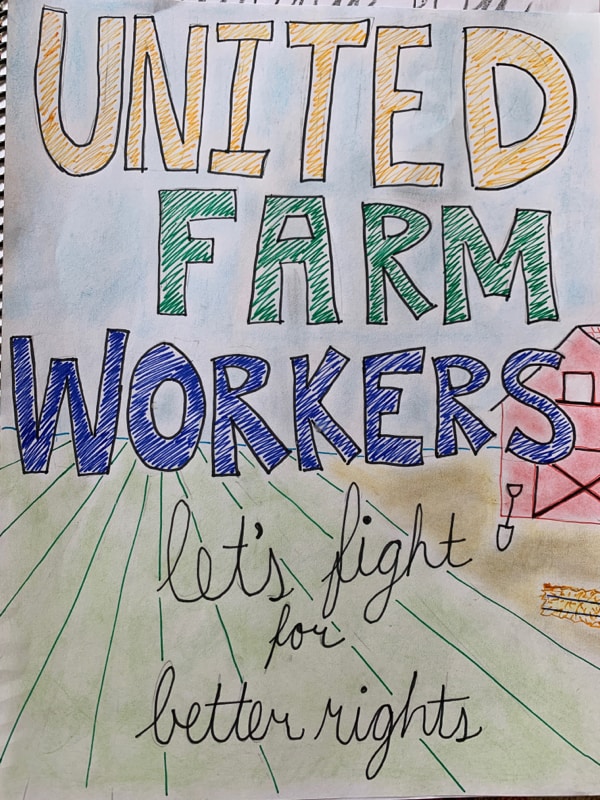
Looking Back….
Here are a few photo albums of the group in action across the landscapes of Peru and Bolivia that sum up many of the adventures, learning experiences, and growth opportunities over the past two months ….
Student Perspectives
The students of TTS 33 took turns sharing updates and insights on what the group has been up to academically over the past few weeks….
Global Assignments
Early on in the semester, we began our weekly assignments called RRQ’s in Global class. We began these assignments with a reaction, specifically describing a moment or experience and saying how it affected us. Then a reflection where we explained how and why we reacted, what questions this made us ask and how it changes and impacts our future. We then wrote a response to questions being asked by someone else.

The experience of writing RRQs has taught me about looking deeper into my day-to-day experiences. I have become more aware of the cultural similarities and differences of where I have been. The practice of identifying and finding reason in my reactions to the cultures I see has made me more aware of my reactions and judgments. While looking at these moments, being asked questions by others, further challenges and opens my deeper thoughts, connections and feelings about my experiences. These weekly assignments have brought meaning to the things that I may never have thought of.
Mock Trial
In History class we were donned the exciting task of conducting a mock trial; The Incan Empire vs. Spain.
The class separated in two to prepare their arguments. Both sides had three witnesses and four attorneys. On the day of the trial, parents gathered to watch the trial and both sides presented their case. The witnesses portrayed their roles dramatically and the attorneys managed not to laugh. For many of us it was our first time participating in a mock trial. We all had a lot of fun and were able to learn more about the Spanish conquest in South America.
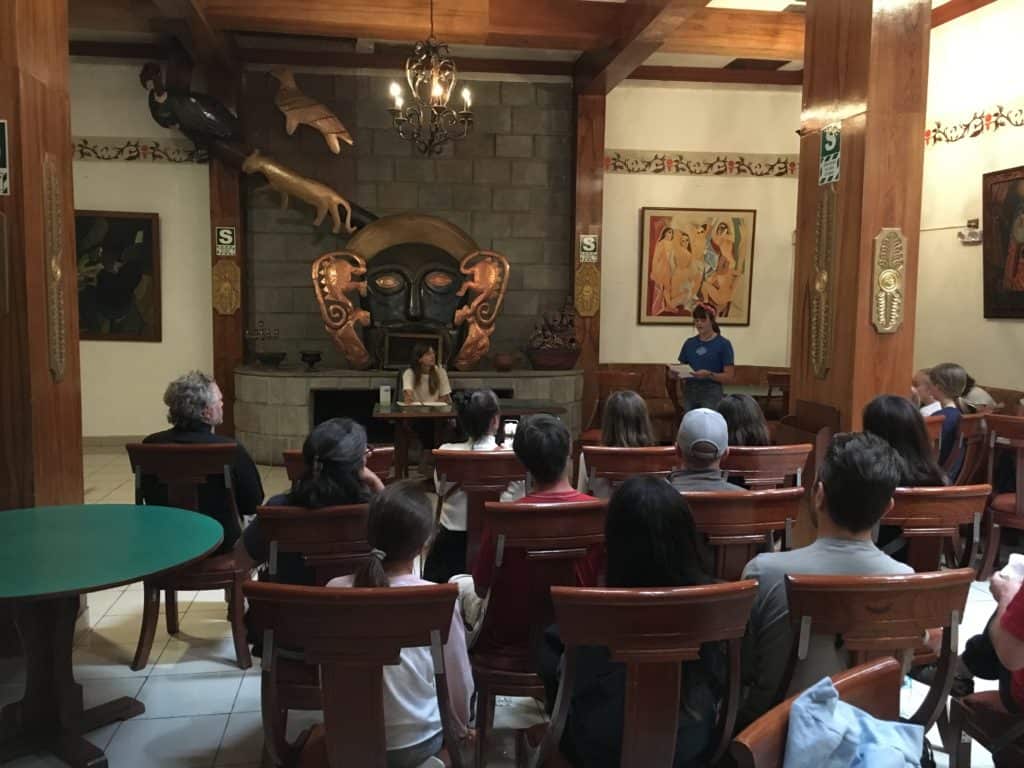
A few days after the trial, the Incan Empire was announced as the winners.
Academics at TTS
At this point in the semester, our day-to-day routine has become quite normal- until we get to class and see there is nothing normal about the classes we are having and how truly incredible the teaching style at TTS is.

This past week we have had some exceptionally exciting classes. In Pisac, we had science in a botanical garden and had the opportunity to draw and learn about plants in Peru. As some parents witnessed, we had a dynamic mock trial in History between the Incan Empire and Spain. It was full of acting, suppressed laughter, and quick thinking that left us with thoughts on the tip of our tongue and everyone wanting to be learning more. In Spanish, the intermediate class has been writing their own legends while the advanced group are making their own lesson plans and helping teach the beginner group. In literature we had class in a round room on the 8th floor of the hostel with hail and rain pounding around us. In Global, we listened to a thought-provoking commencement speech called “This is Water” about how to acknowledge our default setting way of thinking. This left many of us saying it was the most interesting discussion we had ever had! TTS truly embodies experiential learning and it’s hard to compare with our classrooms at home.
Reactions, Reflections, and Responses
This whole semester we have been practicing our writing and observing through the famed RRQ: Reaction, Reflection and Question, due every Sunday night after study hall. These have been a main point of homework stress and anxiety due to the fact that you have to find a partner to switch papers with and write questions about their writing- which usually happens Saturday or Sunday night. Of course, we have improved our RRQ skills over the course of the semester. We are now able to pick the littlest occurrences that have happened over the week- be it phrases, signs, a conversation or an object found at the market. Some of us have even gotten a prized 50/50 on this assignment! We’ve written about glaciers and college, chess and advertisements. Everything you can imagine. We are now faced with a new challenge: RRRs (say that ten times fast). Reaction, Reflection, Response. R3 as Mikaela would say. These are similar, but with more focus on how your observations and thoughts affect your future (and without the stress of your partner writing questions!) Our latest RRR had a special twist: after listening to “This is Water” in Global about how each of our world’s revolves around us, we were challenged to think and write about how our self-narrative perhaps impedes our abilities to empathize with another person to see their whole narrative. We have only a few RRRs left, let’s hope we all get 50s!
Student Work Gallery Walk
As part of the Campus Visit, the students put on a gallery walk to share some of their work with the group. Close your eyes, see the cobblestone streets, breath the high mountain air and imagine you are in Cusco as 17 proud and curious students showcase some of their work……

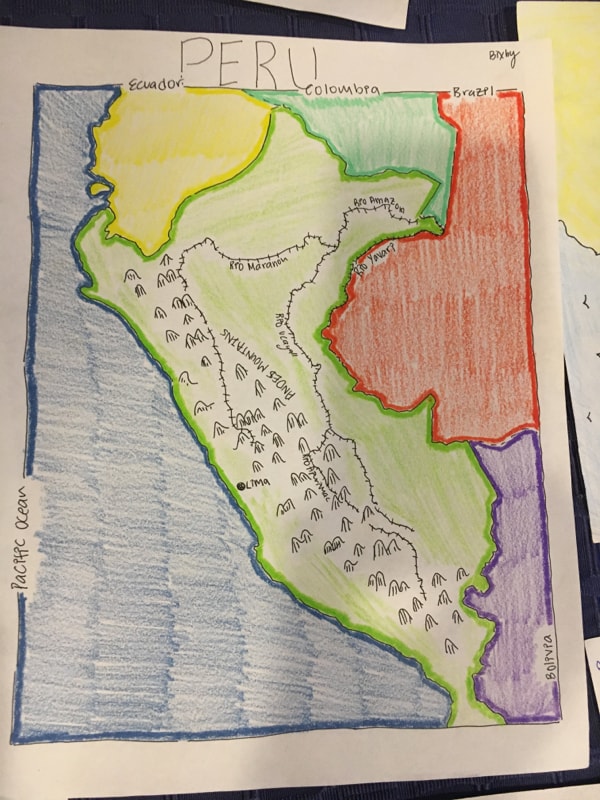














Chan Chan Ruins

After completing midterms in Huanchaco, Peru we could not pass up the opportunity to visit the nearby Chan Chan ruins. Chan Chan, once the capital of the the Chimu Kingdom and home to 60,000 inhabitants, is the largest adobe city in the Americas. As we walked the road leading into the complex, it was not hard to imagine the bustling energy that must have filled the city over 600 years ago. Our tour of the ruins led us through complex passages lined with massive walls and decorative carvings. We learned about impressive irrigation systems that helped support lush gardens how the lack of doors in the labyrinth-like city is thought to be a method of confusing enemies during attacks.
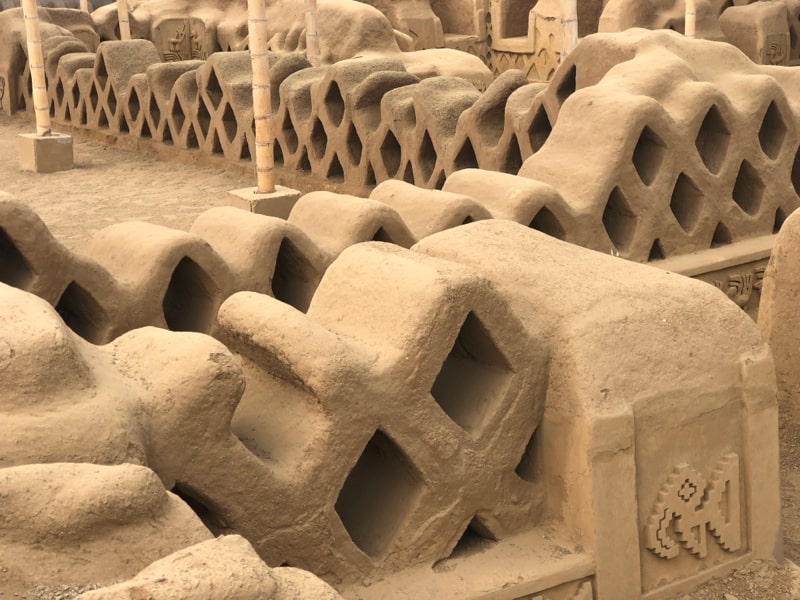

The glory days of Chan Chan ended around 1470 when it was conquered by the Inca Empire and soon after that it was looted by the Spanish. As we rode the bust back to our hostel, students chatted about the visit and wondered what life was like for the inhabitants of Chan Chan. What did it smell like? What did people do every day? What kind of noise filled the streets and hallways? As we piece together our understanding of life long ago, we appreciate how the experiences allow us to walk the same paths as the people we learn about in our history books.

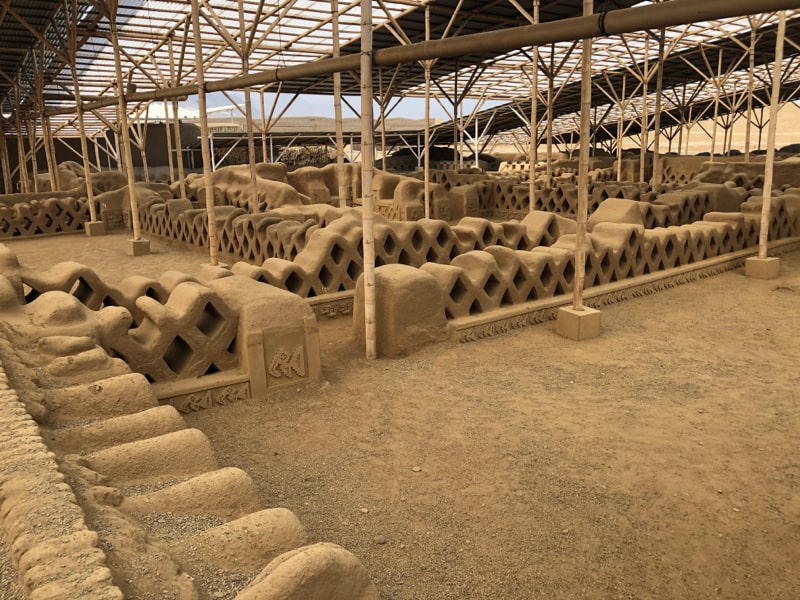
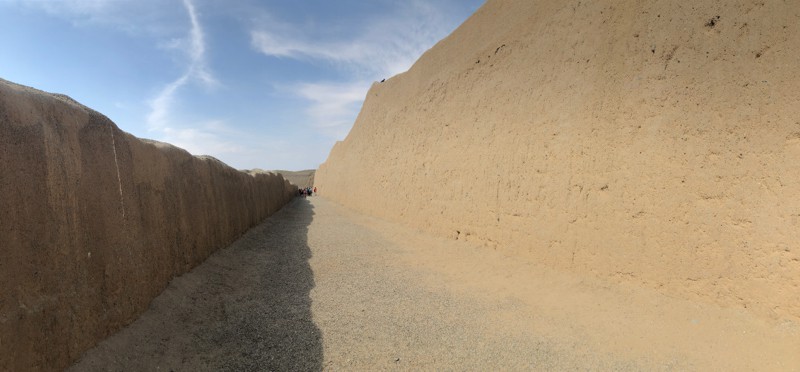
Santa Cruz Trek
The Santa Cruz trek. We had talked about it for many weeks and the anticipation was high for this challenging high-altitude hike. As we made our way into the trailhead on the first day on a winding mountain road, we drifted in and out of sleep because of our 4:00am wake up in order to hit the trail with plenty of daylight hours ahead.

The first day was tough — with 2,500 feet of elevation gain, we made our way through a steep canyon alongside a rushing river. Since Northern Peru is in the end of its rainy season right now, the river was flooded over the trail in some parts, and we danced our way across rocks in order to keep our hiking boots dry. It was our first day of the semester with big packs on, and our hips ached with bruises, but our legs were strong as we felt the power of leading our own way into the backcountry. Students rotated through different roles such as leader (and map reader), group cheerleader, cheers master (hydration expert), and timekeeper. We kept on a rigid hiking schedule: 30 minutes of hiking, 5 minutes of break. We made it into camp that afternoon, with full rain coming down and rain gear being put to the test for the first time. Cold and tired, we huddled into the dining tents and warmed up with some afternoon tea, soon to be followed by an incredible dinner of soup, rice and chicken. Exhausted but content, everyone was asleep by 8pm.


On day two, we started out through a flatter area, hiking through fields of scattered wildflowers. Purple lupines and yellow dandelion-like flowers lined the trail as we wound our way deeper into the valley alongside the river, coming up to a large lake nestled in at the foot of the mountains on either side of us. This day was long, but our thighs and calves felt a bit of relief from a flatter trail, and we marveled in the magic of the colorful wildflowers surrounding us up above 13,000 feet. As we made our way into our campsite, we understood why this campsite was considered one of the most desirable places to camp. Along this wide, glacier-formed valley we were surrounded by snow-capped peaks, a fast-moving creek, glacial erratics, and a rock wall decorated with small waterfalls.


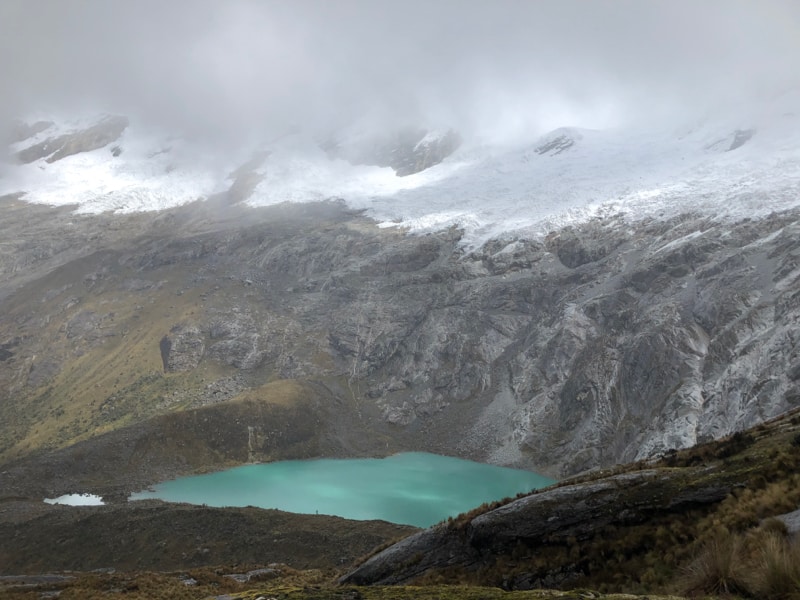

We spent two nights in this large valley. During our layover day we held academic classes. These included a science class guest-taught by Sarah explaining the features that glaciers carved into the landscape, a global studies class focusing on globalization, and a literature class with some read-aloud time in one of our dining tents. In between bits of rain and sunshine, we would sneak outside for some silent time up in the hills looking out over the valley or for a group game. That evening, we took on dinner for ourselves and cooked the most delicious backcountry meal of burritos — including sautéed veggies (on Whisperlight stoves), tortillas, rice, beans, avocados and cheese. Yum! The perfect end to a lovely day.

The next day was the biggest day. About 10 miles of hiking that took us over the pass of 15,600 ft of elevation. This day we stayed as one big group, hiking together and cheering each other on as we climbed up switchbacks straight out of camp. It wasn’t long before we could look down into the valley and see how far we had come and yet how far we still had to go. We continued climbing and behind us a rainbow painted the sky colors, motivating us even more to keep going. When we reached the top, it was pure joy — the feeling of satisfaction and power, knowing our legs could carry us wherever we wanted and to such heights! We were there, after days of hard work, and reaching that elevation with our packs on felt unbelievable.



As a team we celebrated our victory, yet before long we knew we had to get those packs back on and keep on hiking, as we still had many miles ahead of us for the day. After the pass we worked our way down slippery rocks and were greeted with snowfall! Although it wasn’t much, it was enough to remind us of the winter we had left behind. We sat and ate lunch on the rocks, refueling for the muddy walk ahead of us. The rest of that day is a blur, and our hiking boots are still dirtied with the mud from the trails. We finally made our way into a new valley, this time even lower in altitude than the night before. We found our resting place for the night to be a bit soggier than expected. The field we were camping in was almost a swamp, puddles all around us and some llamas watched us from nearby. We didn’t mind, though, as we marveled in the fact that we had come so far and used the power of our bodies to get us there, and the strength of our minds to not let us give up. Our final day hike out was quick in comparison and we hike with confidence this time, our packs feeling comfortable on our bodies and our legs sore but determined. As we made it to the vans, we drove through the mountains back to what felt like “home” in Huaraz, accompanied by some reggae tunes that seemed to perfectly fit the mood. Back in our hostel, we were relieved to come back to warm showers and cozy beds, feeling accomplished. In the past 5 days, we had pushed our own limits and achieved what had seemed impossible by working together and persisting as a team.





Activity Update: Farm Visit, El Altar Trek, Museum Visit, Beach Time and Art in the Park!
Farm visit – from Ella
We started our day off with a bumpy bus ride up into the mountains, arriving at a small but luscious farm nestled in a valley. We wandered down a steep path past trout ponds and beautiful flowers where we met Cesar, the owner of the farm. Cesar explained to us the layout of the farm and how there is one “wet” section in the valley for certain crops as well as one “dry” section located a couple of minutes away on a hill (without irrigation). We followed Cesar through the garden beds of the valley, the sun beating down on our necks. Every so often we would stop and learn about a certain plant or plants, and Cesar would explain their importance to his farm. We learned about rotating crops, soil depletion, plant families, medicinal plants, and so many more aspects of farming, all the while nibbling on bits of fresh kale and carrots. After visiting the guinea pig pen and tasting some fresh herbs, Cesar led us back up the hill to go visit the “dry” section of the farm. Only a short bus ride away, it was noticeably hotter the moment our feet hit the dry dirt. It was clear to see that while the valley was lusciously green with an abundance of produce, this section of the farm served a different purpose. Across the many fields grew quinoa, alfalfa, peas, and grains. Here Cesar taught us the importance of having multiple plants in a single bed in order to keep the soil nutritious. It was clear that every plant served a purpose, and that each aspect of Cesar’s farm was carefully planned out to be as sustainable as it could be. After visiting the dry section, another short bus ride brought us to a community center for lunch. The fresh fish and veggies from the farm could not have tasted better after a long day in the sun, and we devoured our food in minutes. What interested me most about our visit was that while the farm was beautifully simple looking out from the top of the hill, it was actually so complex and interconnected. The way the plants relied on one another by adding nutrients to the soil and keeping away pests without the use of pesticides and unnatural fertilizers taught us the way farming should be.
El Altar – from Nissa
Heading into our first full trek of the semester, I think I can say that we were all filled with a lot of excitement and anticipation to see what was to come. The concept of hiking alongside horses was new to me, but after 10 minutes of walking uphill above 12,000 feet, I was very thankful that they were carrying some of the weight for us.
In our matching knee-high rubber boots, it seemed bready similar to walking barefoot on a ground of pebbles, but we all understood why we were wearing them as soon as we encountered the first stretch of mud. Walking behind each other became a game of choosing the right step, and one wrong decision often led to sinking knee deep in thick mud. One memorable example was when Olivia got her boot stuck up to the rim in mud. One of our guides had to come and yank it free with both hands and a lot of arm strength.
We were soon hiking in what I imagine Ireland looks like – rolling green hills, fog, and an occasional field of Lord of the Rings-like boulders. I have neither been to ireland nor seen The Lord of the Rings, however, so my descriptions may be slightly off, though I now feel as though I have done both.
A few hours later, we reached our home for the next two nights — a quaint bunkhouse in the middle of some of the most beautiful scenery I have ever been in. That night we had a short literature class and at one point we all turned around and watched the sun set behind the mountains.
We then all headed inside for a well-deserved dinner, which I was expecting to e freeze-dried chili. Instead, we were brought some steaming bowls of quinoa soup and plates full of rice and fish. My parents might have a hard time living up to that, considering the food we ate on this trek was more prepared and intricate than what I eat at home not camping.
The next morning, a few of us woke up for a team sunrise viewing. On our walk outside we came face-to-face with a horse which I mistook for a person and Ruby mistook as a tree. We were not actually able to see any sunrise, but we sat and watched the gradual lightening of the sky while being warmed by our tea and sleeping bags. That day we hiked up and over a ridge to a bright turquoise sulfur lake. The fog sometimes covered up what was 10 feet in front of us and other times cleared, and we were able to see the mountain ranges around us. That whole day, I think that many of us thought about how unique this experience is. I mean, how many people get to say that they hiked all day and then had English class in the middle of a boulder field, or science in the heart of the Amazon?
The next day we hiked back down to our starting point, through an even muddier parth, which made for more slips and slides. All in all, El Altar was definitely the most perfect first trek we could have had and it is definitely on my mind to take my family there.
Here are some thoughts people had during the trek:
Olivia: I wish I could be a cow here.
Ruby: This is the perfect field to frolic in.
Allison: I just hung out in the kitchen a lot because it was warm.
Adelle: Why are there so many cows up here?
Ella: How many people can fit in this sleeping bag?
Courtney: I just remember going to sleep with all of my layers on, including a puffy down jacket.
Molly: This is the prettiest place I’ve ever peed.
Arabella: I thought the sulfur lake was cool, but I’m surprised it didn’t smell!
El Altar – from Allison
El Altar was a fun trek. Being from Texas, I have never really gone on a very uphill trek before so this was brand new and a challenge. I think the mud was challenging trying to make sure our boots didn’t get stuck or not sliding through the mud. Needless to say all of our clothes needed washing after this trek. The stops were breathtaking though! Our guides Jorge, Marcial and Raul were so great and were encouraging the whole time. My favorite times were warming up in the kitchen while they cooked dinner or study hall by candlelight. Or walking through the fluffy clouds that gave me a nice mist. The lake was stunning and rock climbing up was even better. Marcial showed us the way to scale the rock section. I am very excited for the other treks to come on this trip!
Pumapungo Museum
“The best way to learn about yourself is to learn about the other.” These were the opening words by the curator at the Pumapungo Museum. Her words left a stirring within me as I began to peruse through the exhibits of indigenous culture. Left to right, there were photos and artifacts from all of Ecuadorian indigenous groups, from clay pottery to golden tools. A group of the German anthropologists had traveled through Ecuador in order to learn about the Amazonian indigenous groups. They documented their travels via photography, intimately connecting with their daily life. Out the backdoor of the museum, there were plots of grass surrounded by stone fences. Each area was dedicated to a ceremony or tradition of the indigenous civilization that was from the land of present-day Cuenca, whether it was for women with children or soldiers.
On the second floor, there was a gallery of many of the indigenous cultures of Ecuador. Each display showed the traditional clothing and explained their diet, customs, and a brief history of their people. I was blown away by the diversity in front of me; in a country that size existed a plethora of multiculturalism within one word: “indigenous.” From the shamans of the Amazon, our time in Agualongo, and to every other group beyond our reach, I finally saw the indigenous platform as a whole through the museum. It was on the walk back to the hotel where the curator’s words struck me again. I thought, “We can see the immediate differences of another culture just by looking at them, but we won’t understand the essential qualities of who they are without spending time with them. By learning how different we are, I can reflect more upon how my life in the US has impacted my values and outlook on life.”
Beach in Mancora – from Lilah
After a long, class-filled day in Mancora’s sticky heat, there was nothing we all wanted more than a swim in the ocean. We ran onto the beach and made a beeline straight for the waves! We jumped over waves and dove under them, we sang “Do-re-mi” from The Sound of Music and had some fun but short-lived chicken fights. Soon after, a group of other girls and I began to play an intense game of frisbee in the shallow water. When there was sand in our hair and our hands were wrinkled with water we walked back to the hostel and enjoyed a hearty and much needed pizza (and salad!) dinner!
Art in the Park
Cuenca, Ecuador is a UNESCO World Heritage site and widely known for its breathtaking colonial architecture. In the Parque Calderon, located in the heart of the city, you are surrounded on all sides by gently parading archways and towering cathedral domes, stucco walls, and red-tiled roofs. Intricate iron railings enclose small balconies that burst with bougainvillea. Inspired by the beauty, we packed a snack and our favorite art supplies and spent an afternoon in the park, getting acquainted with our artistic sides, and sketching buildings using one-point perspective. In this technique, you create dimension and depth by having a single vanishing point on the horizon on which the perspective lines converge. Students experimented with different buildings, perspectives, vanishing points, and fields of view in their respective drawings to achieve the desired effect of balanced lines fading gracefully into the distance. Keen observation and patience, skills that serve any traveler or student well, were especially important here in creating realistic representations of their chosen building. After perspective drawing, we turned our attention to another form of art, one often used as a platform for diverse perspectives on social, political, and economic issues- the mural. Having opened the conversation during an exploration of the murals of Cuenca a few days prior, we asked the students to think of themselves as muralists with a blank wall to paint on the building they had just drawn- what theme would their mural represent, and why? Who would they be appealing to and how would they get their attention?
Academic Class Updates and First Trek!
History Class:
As travelers and history students, we stroll the streets of colonial towns while also listening to stories of the indigenous people who were here first. History class investigates European arrival and how it irrevocably shaped the region. Through conversations, readings and observation, we examine what parts of indigenous culture were lost or have survived.
The class composed “20 Question” poems directed at colonialism.
Questions to Colonialism
By Arabella
Why are we like this?
Why must we feel the need to take, but never give?
What is the driving force of our greed?
Where did the roots of superiority take hold, refusing to let go of the Earth it soiled?
Why do we strive to change what is different?
Can we not learn from the differences of others?
We were born hateful?
Did we learn how to hate?
Who taught them to us?
How did we become blind to our own differences?
Are we not just as foreign to those oppressed for their differences?
If so, why are they not hostile towards us?
When will we learn acceptance?
Can it ever be learned?
Are some too full of hate to love?
Is this way of life not depressing?
And so I must ask, why are we like this?
By Nissa
Did you mean to hurt?
Why did you feel the need?
Who are you doing this for?
Will you ever leave?
Can I ever recover?
What do you want?
Did you expect us to change?
To the culture you flaunt?
Will you let us live on?
And respect our lives?
Or keep cutting us open?
With sharp daggers and knives.
By Olivia
What brings you to this faraway land, full of colors and bliss?
Why do you want to squash our culture and leave it, buried in the Earth to be forgotten?
Is your only incentive money?
Do you not care for the lives you’re ruining, destroying, ending?
Are you even human?
How could you?
Are you proud of your wealth, gained from your maliciousness?
Can you sleep at night with the guilt or have the deaths you’ve caused brought satisfaction?
Why would you walk across our customs and good nature as if you’re ruler of the world?
You treat us like we’re worthless, but do you truly believe that?
Are you scared?
Do you use your aggression as a defense mechanism?
Are you powerless?
Or simply greedy and horrific and terrorizing?
Take it all, our home our culture, our lives, but are you preparing for the day when we’ll come back for you?
The day awaits and while you’re dreaming sweet dreams of murder we will get revenge…

Literature Class:
The past few weeks in Literature Class have been guided by the question: “How can storytelling be used to gain perspective and enact change?” Our Unit began with students unpacking their identities using Mary Pipher’s “I Am From” poem as inspiration for their own poems of the same name. After three drafts, peer revisions and a brief study of spoken word poetry, the girls (and all teachers!) performed their poems late one night in a peaceful circle lit only by the soft glow of lanterns. It was a special evening that revealed both their growth in using poetic devices to express themselves and demonstrated raw and important explorations of personal identity.
We then transitioned into our Magical Realism Unit by diving into several short stories by Gabriel Garcia Marquez, Julio Cortázar, Jorge Icaza, and Mario Vargas Llosa. These stories helped the girls define elements of Magical Realism and begin to analyze themes as they pertain to the human condition. We continued such lessons with our study of Paulo Coelho’s The Alchemist, which the girls read while on our own somewhat parallel journey trekking to El Altar.
Finally, to infuse our final week before midterms with some creativity, we spent our classes in Cuenca observing a series of powerful murals and architectural masterpieces. This provided the girls with an opportunity to engage firsthand with the power of visual art to tell stories that share perspective and inspire activism. They then created their own murals based on values they prioritize in life which you can see pictured below!
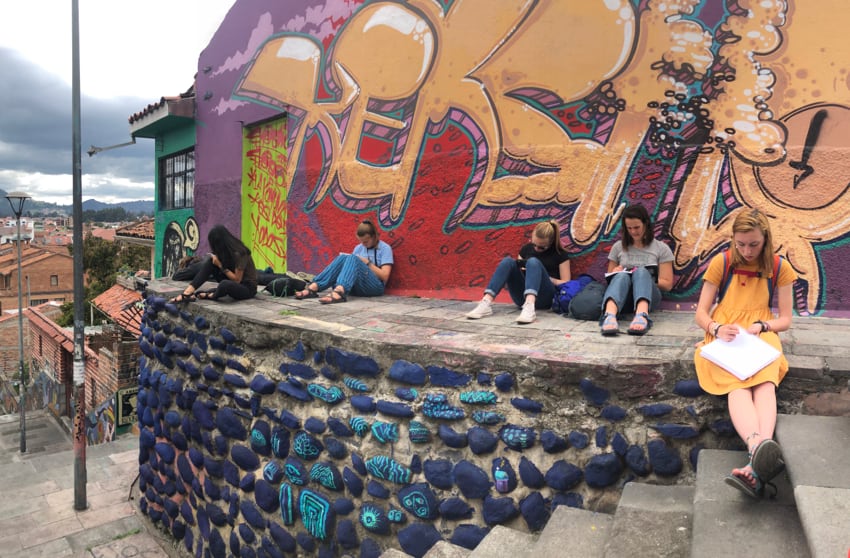

Global Studies:
In Global Studies we have been unpacking the concept of privilege, what it means, and how it shapes inequities and prejudices in society. We recently engaged in a privilege walk where students began in a straight line and moved forward or backward in response to specific questions about their lives. As we work to understand more about the privileges we have and the oppressions we experience, we also strive to understand how these systems affect others. We ask ourselves: How we can become changemakers?
Students also read Privilege 101: A Quick and Dirty Guide from Everyday Feminism and shared some of the most important sentences from the reading.
Molly:
“Being mistreated is likely to leave a bigger impression on you than being treated fairly.”
“We experience the aspects of our identities collectively and simultaneously, not individually.”
Ella:
“Privilege doesn’t mean your life is easy or that you don’t work hard. It simply means that you don’t have to face the obstacles others have to endure.”
Adelle:
“While Individual experiences are important, we have to try to understand privilege in terms of systems and social patterns”
Lilah:
“We call privilege “privilege” because we acknowledge not everyone experiences it.”
Olivia:
“How are you disadvantaged because of the way society treats aspects of your identity? Are you a woman?”
Freya:
“Join us in challenging the systems that privilege some people and oppress others.”
Beginning Spanish:
For beginner Spanish speakers, finding the right word or verb conjugation can often feel like the mental equivalent of searching for a needle in a haystack. In an environment where so much of what we’re seeing, hearing, and learning to speak is new, it can be a challenge to sort through it all and make sense of this new language.
In the activity pictured below, students were prompted with an English sentence that they had to translate into Spanish. All the necessary words were present, they just had to find them! We have been talking about various aspects of grammar, and put that new knowledge into practice by sorting the words into different categories- nouns, adjectives, present tense verbs, etc. Once sorted, the sentence construction became much easier. Through this activity, the group continued to bring order to their mental filing cabinets, and are well on their way to becoming hispanohablantes fantasticas!
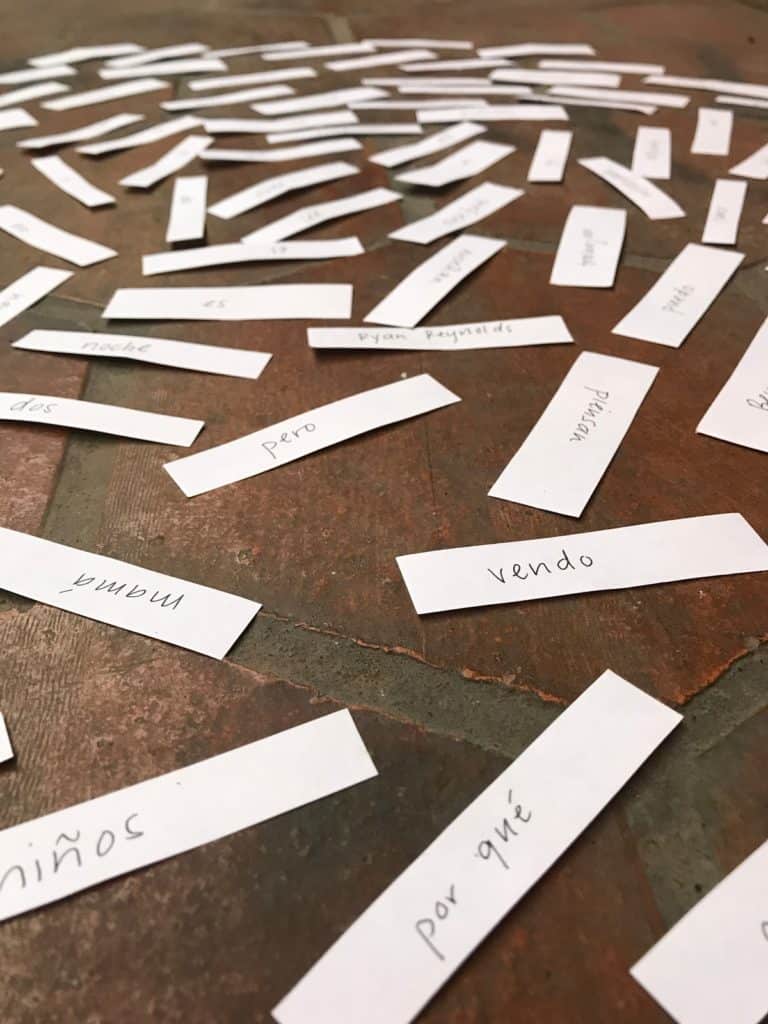
A few pictures from the group’s El Altar Trek….


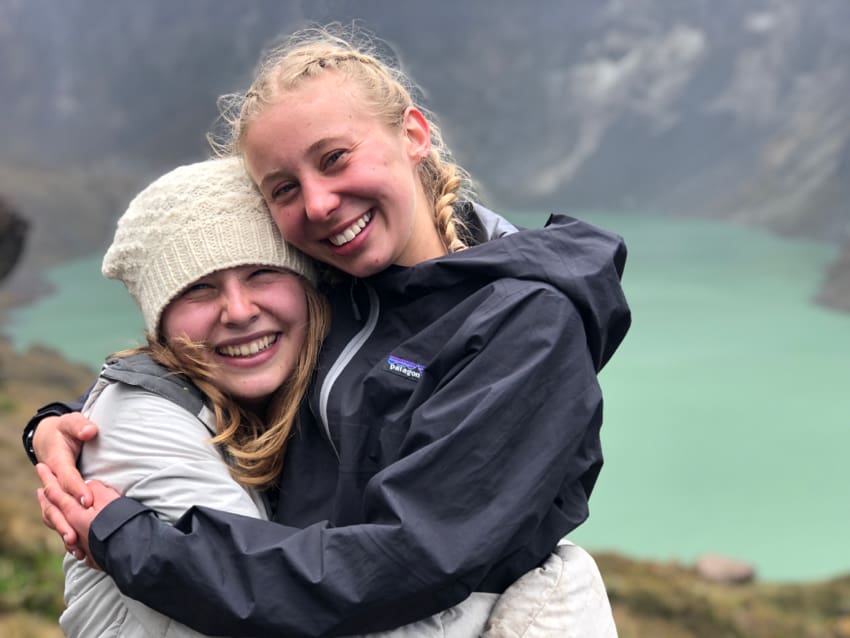


Images from the Field….
As the groups time in Ecuador comes to an end and they prep for a boarder crossing early next week, we thought friends and family might enjoy a recap in pictures. Here is a google album of adventures to date. Happy viewing….
Homestays
Otavalongo Museum:
When heavy rains get in the way of a waterfall hike, spending the afternoon learning about Kichwa culture and history at the Otavalo History Museum is a great alternative. With the help of student and teacher translation, a knowledgeable guide took us through the museum and provided thorough background information and stories about everything from celebrations, to dress, family structure, cooking, crafts, and farming. We viewed a live demonstration of traditional weaving and learned about how many of the items we have seen in the markets are made. The museum is situated in what used to be a Spanish Hacienda in 1821. In the 1950s it became a textile factory where indigenous people were forced to work under terrible conditions and is now a museum with potential to include a large community space.
Homestays:
Our homestays started with the most amazing and warm welcome we could have imagined. As we rode in the back of a large truck on our way into the Agualongo community, we didn’t know what to expect and we could hardly see why the truck stopped as we neared the community center. When we stepped out, the entire community was waiting and throwing rose petals towards us. They welcomed us in Spanish and Kichwa, and we walked down the road together to the community center where they had spelled “welcome students” in Spanish on the ground with rose petals.


After our initial night, during our first full day of homestays, we spent the morning working with Tandana staff debriefing of the first night. We told stories about the laughter and charades over dinner while trying to communicate with families, funny interactions with the kids, and the large portions of rice accompanying our dinners. In the afternoon, we hiked up to the top of the nearby hill to look out at the hacienda next door while we discussed the history of the community and farming systems throughout Ecuador.

The next two mornings were spent participating in “mingas,” a Kichwa word for community work. In Agualongo, every family is required to send a representative to participate. The first minga was dedicated to cleaning out the drainage ditch along the cobblestone road. Over time the ditch fills with dirt and debris which causes the road to flood during heavy rains. Working side-by-side with our host moms and siblings, we hoed and shoveled our way up the road, leapfrogging over one another and making amazing progress over the course of the morning. We came out of the minga all smiles, cheeks rosy from hard work and the intense Andean sun!
The second minga fell on Saturday morning, and was therefore attended by both the men and women of the community. The goal: completing the last stretch of fence around the soccer field. The field, or cancha, lies at the heart of Agualongo and its sports-loving people. Pickup soccer games occur at all hours of the day and night, and over the weekend we had the opportunity to watch equavolley, a variation of volleyball invented and played in Ecuador. The day’s work consisted of excavating dirt, moving rocks, and transporting the concrete foundation forms for the fence line. Everyone had the opportunity to work with and get to know people outside of their own host families and help complete an important community project.

The next day we hiked high into the Agualongo hills with our host families, up to the top of a hill where we had views of the volcanoes surrounding us: Imbabura, Cotacachi and Mojanda. As we settled into the grassy hilltop we sat by small fires built by our host mothers and rolled pre-made dough into some delicious pancake-like patties. We spent hours rolling dough patties and chatting around the fire, marveling at the wonderful discussion that can happen over a campfire. Cooking has the ability to be such a powerful connector between people. Although there were three languages spoken around the fire, we created a beautiful bond built between teamwork and laughter with everyone working together to provide a delicious meal. When it was time to eat, we paired our bread patties with a “pambamesa,” a mixture created by combining foods brought by each family. For our day, they mixed beans, popcorn, potatoes, rice, lentils, noodles, vegetables (and more) together in a big bucket and served a small amount to each person. After the meal on the hilltop during which we all crowded into the small bit of shade, we worked our way down the hillside back to the community which was beginning to feel like home.
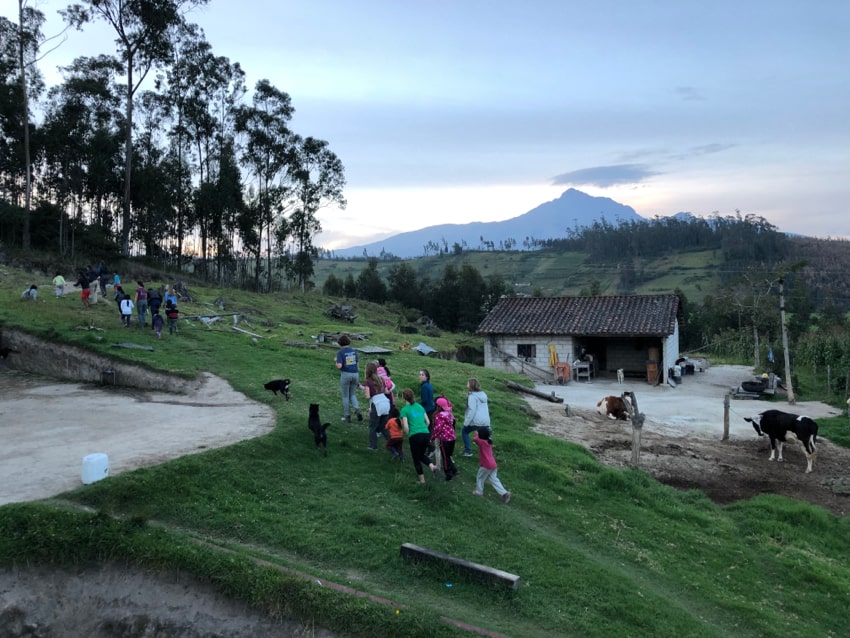
Our final activity day was spent at the Kaysawmi Cooking School and began with a 40 minute walk through the green hills of Agualongo toward the next town. Claudia, the owner and head chef at the School, welcomed us into her kitchen as she passed out our bright pink cooking scarves. Her story, she shared with a smile, is quite intimately connected to The Traveling School. Anna Taft, a past TTS teacher and Founder of The Tandana Foundation, had befriended Claudia while living in Ecuador. Years later, upon arriving in the Agualongo community with her TTS students, Anna reached out to Claudia for an informal cooking lesson. Claudia was excited by the offer and agreed to invite this new group of teenagers into her home to learn more about Andean cuisine. We are grateful Claudia had such a positive first experience sharing her talent as that first class became her motivation to start the Kaysawmi Cooking School. Now the school is a beautiful dark yellow cottage tucked behind large trees and sprawling gardens, enticing future chefs to experiment in the kitchen.
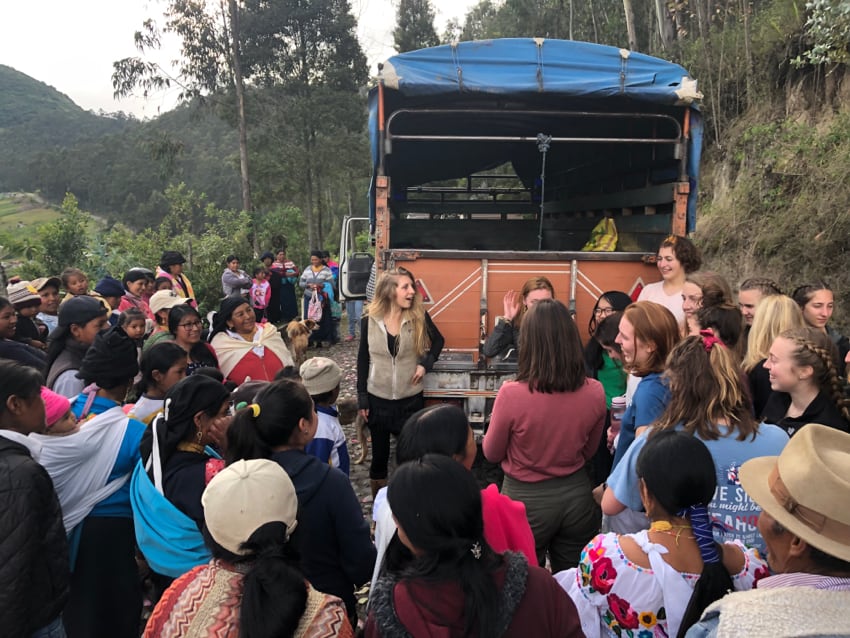
Throughout the day, we toured its fields of medicinal plants, prepared delicious Andean sauces, salads and desserts in traditional clay cookware and grilled chicken over a small fire surrounded by 30 squeaking guinea pigs.
We learned firsthand the flavor of freshness. We used herbs and spices picked from the garden, steamed sponge cake in palm leaves and blended juices and spices in homemade mortar and pestles. Once our meal was ready—perfectly marinated chicken, beet salad sprinkled with parsley, fried golden potato patties, bright red ahí sauce and steamed raisin sponge cake—we enjoyed our food while listening to Claudia’s husband and friends play local tunes. As the tunes of their wooden flutes, violins, mandolins and guitars filled the room with energy we went outside to enjoy a dance party on the lawn.

After our well-deserved feast and some silly dancing, we switched gears and jumped into Literature, Science and Math class before heading back to our families in Agualongo.
Before we knew it, the week was over and it was time to say good-bye. Adelle prepared a speech and spoke in both English and Spanish on behalf of the TTS community:
Hi Everybody!
On behalf of TTS I wanted to thank you all so much for hosting us this week. It was a blast. You have all been the most welcoming, lovely, wonderful people and I hope that we have been wonderful too. I know that this has been my favorite part of this trip and, if I had my way, I would stay here forever. As Nissa said, “What do I have to do to get kicked out of TTS so I can stay?” Anyways, this has been wonderful, and you have been wonderful, and we are so grateful you welcomed us into your homes. We will forever remember you, Agualongo!
Thank you!
Hola a todos,
De parte de nosotras del Colegio Viajero, quiero agradecerles por haber abierto las puertas de sus casas durante esta semana. Nos divertimos mucho. Ustedes nos han dado la bienvenida, han mostrado mucho cariño y vemos que son muy buenas personas. Espero que nosotras hayamos sido buenas personas también. Yo sé que esta semana ha sido la mejor parte del mes que pasamos en Ecuador para mi y si yo pudiera, me quedaría aquí por siempre. Como dijo Nissa, “¿Que tengo que hacer para que me dejen aquí en Agualongo?¨ Pero bueno, esta semana fue increíble y les agradecemos por invitarnos a sus casas. Vamos a recordar su comunidad por siempre.
Gracias!

Final Goodbye Reflections (from Adelle)
The first thing I did at the despedida was walk to the wrong building. The second thing I did was wait for a half hour for everyone to arrive (Ecuadorian time!). Everyone crowded into the room, my family, my extended family, and all the other girls; families and extended families. People sat on the floor and in tiny children’s chairs brought in from somewhere. When everybody was inside and began to get quiet the goodbyes started. First the president of the community spoke and then the vice president, followed by a prayer led by my host dad. The beautiful thing about this prayer is that everyone stands up and speaks as one, their voices echoing. Everybody sat down and the floor was cool, there was a random dog and one by one at least one person from every host family, every TTS student and TTS teachers stood up and gave a speech. It was a long hour and a half process since there was a fair amount of translation necessary, but every single word spoken was full of love and gratitude. It was amazing hearing the stories and the connection that every single girl had with the families and vice versa. I almost teared up when my parents spoke. It seems so funny that one can have such a strong connection in such a short time period, but I had- and am having-a hard time finding words to express the gratitude and love I feel for the people of Agualongo. Being at the despedida and hearing everybody’s stories and sharing smiles across the room, I really felt as though everybody there genuinely connected with each other even through the language barrier. It turns out that everybody has the capability to love and be loved through something as simple as a shared smile. As we finished up our last week, a hilarious week in review skit that crossed all language barriers and camp song, we dived into our final meal of guinea pig. It’s quite good, a bit bony and tastes like chicken. We finished our meal and began to drift out of the hot humid muggy room giving hugs and goodbyes, our last token of gratitude.
A Classroom Without Walls
As we make our way through the third week of TTS33, academic classes and activities are in full swing! Students embrace the ways classes look differently on semester and become increasingly comfortable bringing camp chairs to class, working on assignments in hammocks, and viewing the spaces we enter as potential classrooms. Whenever possible, we gather in a circle to support active discussion and full class participation. We’ve also embarked on several enriching academic activities, including science observations in the Amazon, history lessons in museums, and Spanish classes in the market. Nightly study halls provide productive space to complete homework assignments so that students are able to take full advantage of their days. Interdisciplinary themes addressing environmental issues, indigenous rights, economic systems, identity, privilege, and transculturation have shaped our first few weeks.


In Beginning Spanish, students learn basic phrases to support their interactions with our guides in the Amazon and to shop at the market in Otavalo. They construct basic sentences to describe themselves and their lives to encourage their conversations with their homestay families. Additionally, students focus on increasing their vocabulary and embracing the immersive environment they are in each day!

In Intermediate Spanish, students practice speaking skills with each other in class as well as with individuals we meet and work with outside of our community. Our activities offer many opportunities for students to translate for the group, including lessons on biodiversity in the Amazon as well as stories from our tour at the Otavalo Museum. While in Otavalo the class began Spanish Immersion classes, where students worked with teachers from Otavalo and toured the Plaza De Ponchos. The class reads about the connections between language, culture, and identity while applying these ideas to our own identity as Spanish speakers. As we begin homestays, we begin our review of the pretérito and imperfect and continue to build our speaking skills so we may share stories and memories from our lives at home.


Advanced Spanish students develop their sense of identity as Spanish speakers by writing ‘I am from’ poems in Spanish. Speaking practice in and out of class is emphasized and students are required to practice at least 4 hours per week. During many of our group activities Advanced Spanish students embrace opportunities for translation.
Algebra II students work diligently with polynomial equations and have begun their study of factoring and identifying x intercepts.
Precalculus students bring their unit on advanced trigonometry to a close as they look forward to a new chapter on polar coordinates and vectors! Cosines, calculations, and critical thinking have been enhanced by views of the Rio Napo and beneath the flowers in the cobblestone courtyard of our hostel in Otavalo.
Science class focuses on ecosystem and species interactions. This understanding is deepened by interpreting the complexity of the rainforest during our jungle hikes. Students begin their relationship with nature journaling and turn in their first field journals. As the first unit on abiotic factors in ecosystems and plate tectonics comes to a close, we look forward to moving into our study of natural resources.

The question “Why Do Humans Tell Stories?” guides the first unit of Literature class. Excerpts by Eduardo Galeano, Natalie Goldberg and Pam Houston have informed us about the value of literature and storytelling, methods for personal reflection, and the connection between nature and the human experience. We also explore poems by Mary Pipher, Eduardo Galeano, Gabriela Mistral, Alfonsina Stormo, Juana de Ibarbourou and Emanuel Xavier. Using Mary Pipher’s ‘I Am From’ poem as a guide, the girls work to compose their own identity poem that will be performed in front of our community this weekend. Writing poems challenges girls to process their own identities using tools discussed in Global Studies class and literary devices introduced in Literature.
In History, we begin by asking ourselves, “What is history?” and “Who determines what parts of history to share?” Viewing the study of history with a critical eye invites students to ask questions about sources and to seek more than a single story from the past. Our sense of place begins with the study of local geography. Mapping the country, its diverse environments, and the places we visit support student’s understanding of factors influencing agriculture, urbanization, and economic resources. We define colonialism and explore the ways it affects people, places, and culture. As we prepare for homestays, we begin conversations about indigeneity and land reform while reading excerpts from Open Veins of Latin America and Born in Blood and Fire.

Before journeying into the Amazon, Global Studies class focused on the issues surrounding Ecuador’s activities in the Amazon and their complicated relationship with oil. The class read and discussed several articles while attempting to construct solutions to the problems they identified. The class also embarks on conversations about identity and privilege, examining stereotypes, biases, and misrepresentations within our community and in the communities we visit. Unraveling these ideas continues throughout the semester as we also prepare for our next unit on globalization and international trade.

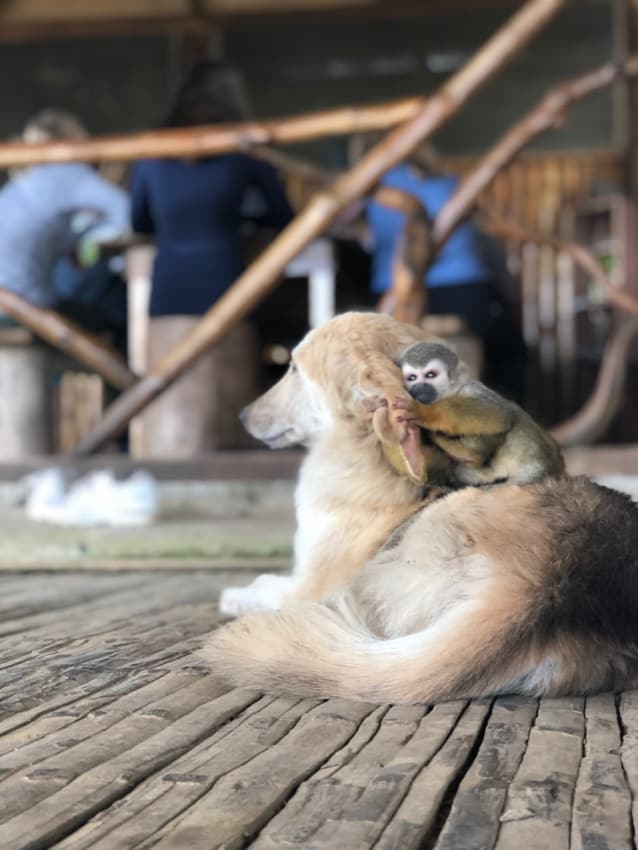
Adventure Game On
Rafting
Leave it to the Jatun Yaku (meaning ‘Big River’ in the indigenous Kichwa language) to help our girls believe that they are indeed capable of anything. This rainy day spent on the class 3+ rapids of Tena’s biggest river afforded all 18 students the opportunity to get soaked by smashing rapids, navigate eddies and holes like pros, and enjoy a dance party or sing-a-long when calmer water presented itself.
When the day began the girls were excited and nervous—many had never been rafting before and the looming clouds of a rainstorm didn’t help ease their butterflies. Alas, from the moment they hopped on their blue inflatable seats and started learning their stroke techniques and river commands, they were giddy with anticipation. Despite the girls meeting hardly 3 full days earlier, they gracefully embraced the challenge of coaching one another through fears and practicing resiliency as they laughed through a nagging, soggy downpour. Our guides, some of whom are highly regarded kayakers in the Ecuadorian whitewater community, were exceptional. They taught us all sorts of water and beach games, prepared a tasty burrito bar for lunch and provided us with an immersive Spanish language and cultural experience. All of this, in addition to their extensive knowledge and safe navigation of the river, was secondary, however, to the way they helped our girls find the fearless teammate and resilient leader that lives within each of them.
“Going into the day I was worried I wouldn’t have any fun—it was my first time rafting in another country, I was nervous I wouldn’t understand the guides and I didn’t know my boat mates that well. But I ended up having a blast. Sometimes you realize your fears aren’t the things you should actually be afraid of” -Hazel
Amazon Trip
We started our journey into the Amazon Basin by heading out from our hostel in a bus along winding roads to a trail that would lead us to a waterfall. Our rubber boots were essential, and still weren’t enough prevent us from getting muddy. We set out toward our destination, crossing small streams and stopping for creatures along the way including a poisonous frog stunningly camouflaged as a decaying leaf, a centipede known by the shamans of the area as a messenger train, and a small freshwater crab that doesn’t let go once its pinchers have grabbed on!
Our day continued with a visit to a local women’s cooperative where we were invited to participate in a traditional kichwa dance. The women welcomed us with open arms and we danced, more than 30 women filling the traditionally built home.
Later, as we settle in to our jungle lodge, the sun is setting behind us above the canopy sprawling as far as we can see. We’ve arrived after a full day of adventure, and the view is accompanied by the laughter of the students playing games in the hour before dinner.
We woke up the next morning to the sounds of birds chirping, and the music of the rain on the rooftops. Our guides, Nixon and Jerson took us on a jungle hike for most of the morning. The jungle unfolded before our eyes as Nixon and Jerson interpreted for us the complexity of the ecosystem which we were passing through. We tasted lime flavored ants that our guides found for us inside of a flower, we inhaled the air from leaves that our guides broke which cleared our sinuses, and encountered one of the biggest trees we had ever seen only to learn that it is just 100 years old. That afternoon, we went across the river to visit a traditional kichwa farming system where we helped harvest and plant yucca to learn about preparing the traditional “chicha” beverage served at ceremonies and celebrations. In the evening we faced our fears by heading out to the jungle in the night and saw more grasshopper varieties than you can imagine, an extremely beautiful and dangerously poisonous frog, and a full size tarantula hiding in a hole in the wall.

We started out next day at our amazing Amazonian lodge in true fashion to the rainforest: rain and sunshine fluctuations within hours. Luckily, with hammocks protected from the rain, we were able to watch the rain tranquilly. After another tropical Ecuadorian lunch, we headed out into the jungle. Even after a week in the lush green, it still felt amazing to feel small in the huge world of the Amazon. Nixon and Jerson, our guides, shared stories about the kichwa customs and the connection they share with nature. We even had our faces painted with a natural paint called achiote, ranging from typical kichwa symbols to our guides letting us draw designs on their faces. Many of our students were translating to the group, expanding their Amazon vocabulary. Later that night, we had a bonfire, where we heard stories about shamans, spirits of the forest, and kichwa folklore. Sitting in a circle so invested in the stories, it was fairly easy for them to give us a scare during the supernatural storytelling.

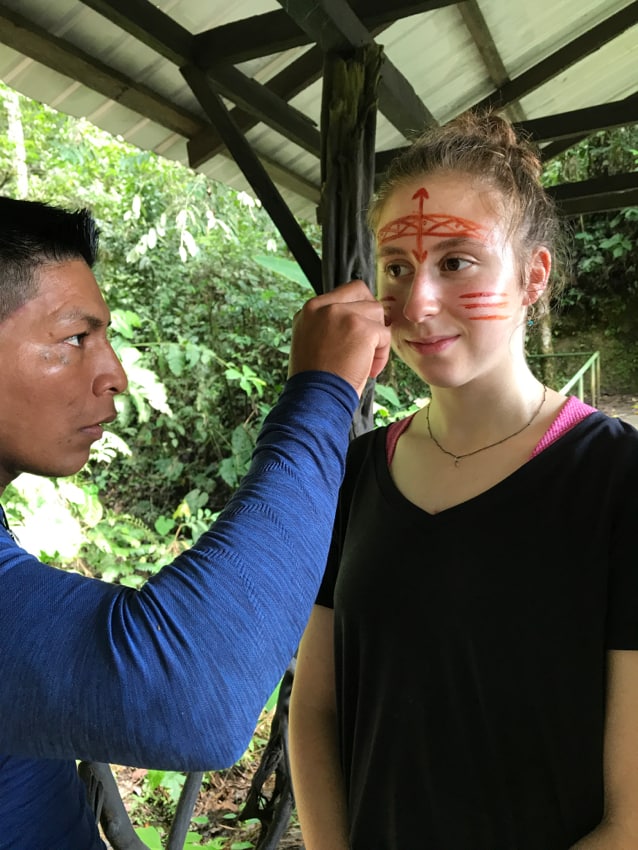
On our final day in the Amazon, we packed our bags early and headed out on our way to a chocolate farm. After many days of fruit filled dessert, we were all ready for a delicious and chocolate-y treat — well deserved after we roasted, peeled, ground and prepared it ourselves! Then we headed into the canoes and while we boated along, we spotted both monkeys and caimans. For our next stop, we watched a local kichwa woman construct a clay bowl in front of us. She described the seven day process and clearly demonstrated each step of the way including painting with natural dyes and polishing with a special rock.

As we returned to our hostel, amazingly it felt like being back home and although it’s great to be here, we’re looking forward to a change of climate and environment coming up soon!


First Few Days
Sitting under the roof of our open air lodge in Tena, we listen to the rain pour onto the roof as we look out over the Lupi River cutting through the green forest surrounding our temporary home. The conference room in Miami and meeting each other as strangers already seem like a distant memory. TTS33 has gotten off to a wonderful start, as our group sinks into the rhythms that will soon shape our semester. Our travel day to Ecuador was tiring, but the girls showed their preparedness and positive approach to travel, successfully navigating through airports, flights, and a bus ride before landing in our beds in Quito for a quick night of sleep. On our first morning in Ecuador, girls examined maps of the region to orient themselves and get a vision of our route in the coming weeks. We met our driver Humberto, who drove us by bus to Tena, stopping at one of his favorite lunch spots along the way.

The group settled into their cabins here at Establo de Tomas, took an afternoon dip in the refreshing waters of the Lupi River and explored the grounds, dotted with heliconia flowers, bamboo plants, and a talking macaw! We held our first day of “mini classes” where teachers introduced their classes, foreshadowing curriculum overviews, projects, assignments and expectations. The group expressed excitement about academics and quickly adjusted to sitting in camp chairs rather than at desks. As we sat in a circle on a wooden footbridge over the river, one student exclaimed “This is the coolest place I have ever had history class!” In addition to our introduction to academics, we’ve also addressed many orientation topics, from hygiene, to safety, to how to stay organized on semester. Last night after completing the first study hall, everyone engaged in a short meditation and were invited to set intentions for the semester before composing letters to themselves that will be returned at the end of the semester.


After our day of taster classes, the group excitedly prepared for their first of many adventures, rafting on the mighty Jatun Yaku! Giggles, screams and cheering echoed across the river as they practiced paddles strokes and responded to their guides’ Spanish commands.



Orientation and They are Off!
After months of anticipation, build up and excitement, TTS33 convened in Miami for orientation. A lot was fit in to a small amount of time. After swim tests, packs checks, lots of laughs and hugs goodbye to family, the group walked toward customs with backpacks full and minds open to embark on their journey.
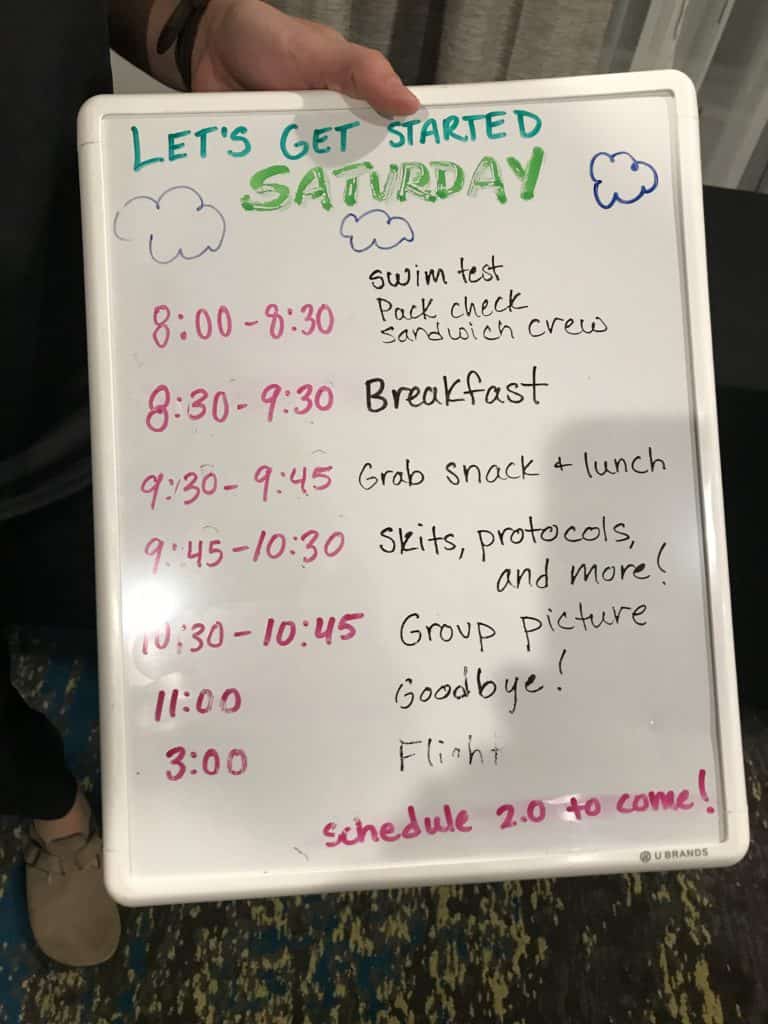
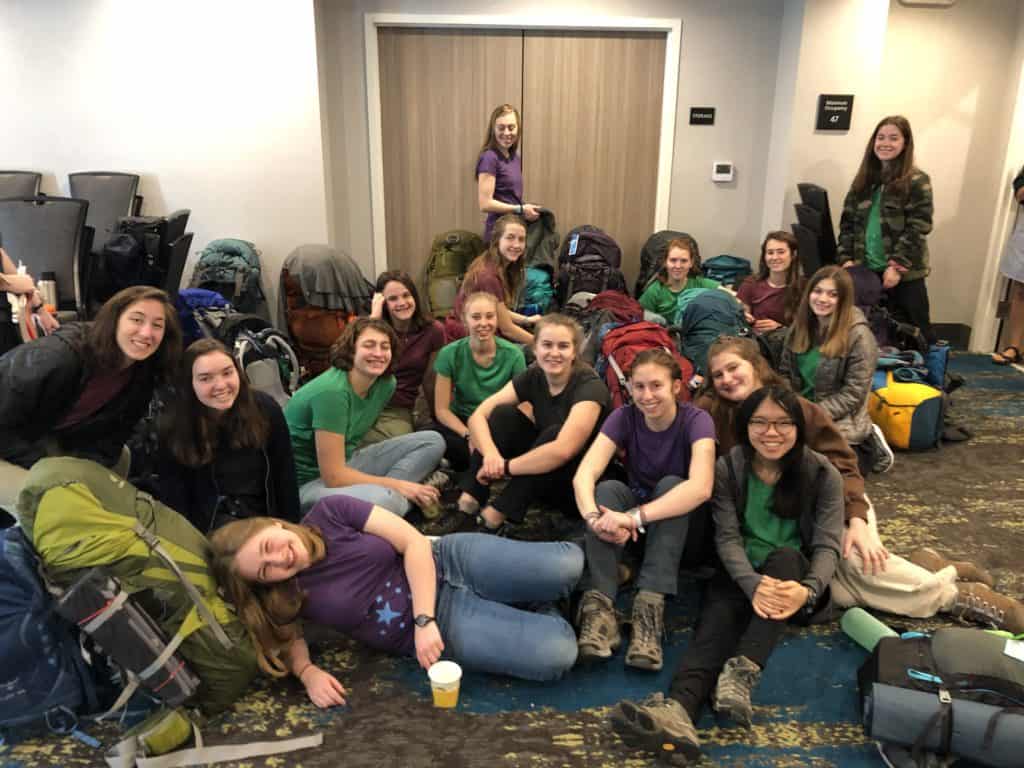
Below is a poem that Autumn shared with the group during orientation….
For the Traveler
Every time you leave home,
Another road takes you
Into a world you were never in.
New strangers on other paths await.
New places that have never seen you
Will startle a little at your entry.
Old places that know you well
Will pretend nothing
Changed since your last visit.
When you travel, you find yourself
Alone in a different way,
More attentive now
To the self you bring along,
Your more subtle eye watching
You abroad; and how what meets you
Touches that part of the heart
That lies low at home:
How you unexpectedly attune
To the timbre in some voice,
Opening in conversation
You want to take in
To where your longing
Has pressed hard enough
Inward, on some unsaid dark,
To create a crystal of insight
You could not have known
You needed
To illuminate
Your way.
When you travel,
A new silence
Goes with you,
And if you listen,
You will hear
What your heart would
Love to say.
A journey can become a sacred thing:
Make sure, before you go,
To take the time
To bless your going forth,
To free your heart of ballast
So that the compass of your soul
Might direct you toward
The territories of spirit
Where you will discover
More of your hidden life,
And the urgencies
That deserve to claim you.
May you travel in an awakened way,
Gathered wisely into your inner ground;
That you may not waste the invitations
Which wait along the way to transform you.
May you travel safely, arrive refreshed,
And live your time away to its fullest;
Return home more enriched, and free
To balance the gift of days which call you.
~ John O’Donohue ~



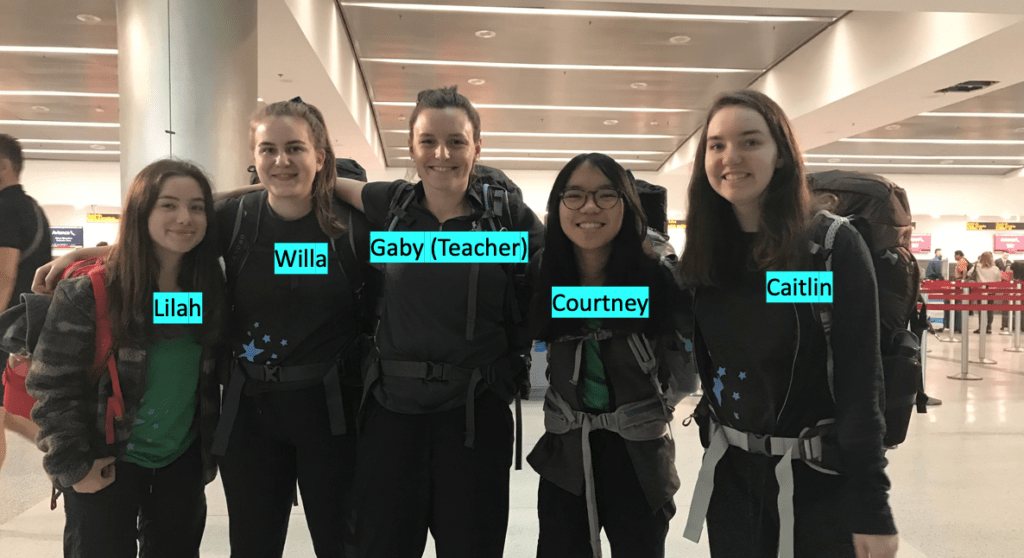

And So It Begins….
Carolyn Hamilton is an alumna parent. Her daughter, Frances, was on the 2018 semester in southern Africa. As the next adventurous and curious band of young women embark on their own adventure, she wanted to share some advice and perspective…
On this winter morning, I ask myself again, how does this happen? How does a young woman find her voice, set her footing, locate her path to impact, celebrate friendships, provide context for her own feelings, and give form to her dreams in a single semester?
Frances has been home from Southern Africa for a month. And in that time, with her face framed in the new bangs she cut as the resident hair stylist for TTS32, I have witnessed her upload 3,000 photos, FaceTime her TTS sisters daily, describe the personal impact of Apartheid on her host mother, Sylvia, whose striped cotton pants Frances wears with love. Frances has shared insights on diamonds, black rhinos, flora alongside the trail up Lions Head, and the fading relevance of the brilliant San People. When nudged, she whispers about important personal moments, like the time she stood alone above the Orange River; sang a cappella with another student in a concrete public bathroom; connected “through the language of emotion” with a child on a dirt street in Soweto. Daily, I’ve watched her radiate a sense of self, dip into her new reservoir of patience, wield new tools for contending with life’s dissonance, and wonder about how to keep her TTS experience close. Lately, she’s actively straddling her experience by raising funds for a cause in Namibia and making brave decisions about her own future.
For clues about how this can happen, I read three months of my sentemails this morning, most of which were directed to the home office, many to family and also friends. In each case, I noticed gratitude, the origins of which I’ll share with you here.
In writing this welcome, I feel like I’m handing you my favorite book to read for the first time: I’m jealousof what you’re about to experience and I cannot wait until you’re finished so we can talk! Until that time, I am grateful for:
- TTS Office Staff. (Jennifer, Aunge, Leah, Dalton, Laura and Elsie) For nearly a year, I watched their names sail into my inbox with group updates or responses to my questions. Knowing what we needed and when, they guided us with cheer, pragmatism and maternal instinct. I told them I was going to have withdrawals. I have them. Some days I just email to say hi. Among a hundred other things, these women published the blog and Instagram posts, which served as vicarious expeditions for us parents. We crouched over our devices, sighting our wild, precious daughters – her headband! her smile! her handwriting! From these posts, I learned to let go and hold on at the same time. One night, I scanned a photo of our daughters in a delta I couldn’t name, balancing in boats I couldn’t name, on which day I wasn’t sure; but there was a glimpse of my kid, concentrating. I zoomed in and stared. Letting go, holding on. TTS staff works tirelessly and cares deeply, period. Once, Dalton lovingly sent me a high-resolution blog photo of Frances just because I asked for it.
- Fellow Parents of TTS32.We became friends! We mused about our girls’ sunrise dune hike or the art in their field journals, but also about dreams, worries, politics, and dinner plans. One friend started our parent Facebook page, becoming our Town Crier. With her spoken and writtenMississippi accent, she announced updates, sending us racing to our screens. I swear, I am plotting a parent-reunion!
- TTS Teachers.These four women held our daughters for 105 days and simultaneously held space for them to be, evolve, take stands, forge connections, and be vulnerable. I can never know what they did hourly, but I will be forever grateful for the mentor comments these women wrote, which implied that, hourly, they were fully present. How else could they know my daughter so intimately and describe her with such care and precision? More than once, Frances conveyed sitting with a teacher just to talk. Once, she said she didn’t just lovea particular teacher, but wanted to beher. These women taught, jumped, probed, dreamed, ate, hiked, reflected, and ached with our daughters, while guiding them to personal and academic depths andasking during long drives if anyone needed a bathroom break!
- The TTS Mission. Not just a set of inspirational words, but alive with intention and the capacity for fulfillment. I promise you, nothing happens that hasn’t been considered as it relates to the emergence into the world of your daughter as a strong, sensitive, aware, capable human.
- Inspiring TTS Young Women. I learned all of their names and asked about them on phone calls. I wanted to be closer to them because they were doing it! Their courage, determination and desire to connect with the world led them to TTS. Their resilience, friendships, curiosity, and spirit kept them moving – inward and outward. Their writing and reflections revealed their raw, critical, poetic, and hilarious sides; and their accounting of the world shines with the understanding that to be vital on the planet is to be open. They are my child’s dearest friends.
- YOU! As your daughters adventure beyond you, you will adventure beyond them. You will play, work, grow and worry; you’ll be proud and you’ll hear deep vibrating silence in your home. Your heart will balloon anddeflate. Your daughters will soar and they will ache…and you won’t be able to fix it. But they will, alongside their sisters and teachers, find their way. And so will you. Days will creep by, months will fly. And, suddenly, you will arrive at the end, all filled up with gratitude, and in so many ways brand new!
Parting words. Some phone calls with Frances were more lighthearted, some more paced and contemplative; one call included a story of Frances looking up during class and locking eyes with a bushbaby in the tree above her. But I will never forget the first call. Three of us sat around the computer, her older sister not yet gone to college. The tone of international connection. The fuzz. The pause. And then Frances, breathing in gusts, a whirlwind of words, declaring she had a list so she wouldn’t forget a thing. “So! Mom and Dad! Just so you know! I want to live here forever – in Africa — happily ever after!”
And so it began. And, so you begin. And, yes, I am sojealous.


